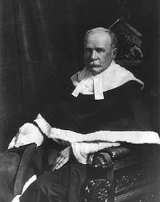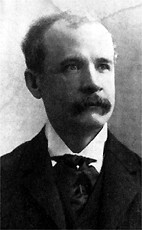
Charles Fitzpatrick
Encyclopedia
Sir Charles Fitzpatrick, PC
, GCMG
(December 19, 1853 – June 17, 1942) was a Canadian
lawyer and politician. He was born in Quebec City
, Canada East
, to John Fitzpatrick and Mary Connolly.
He studied at Laval University, earning his B.A.
degree (1873) and LL.B
degree (1876). Called to the bar of Quebec
in 1876, he established his practice in Quebec City and later founded the law firm of Fitzpatrick & Taschereau.
 In 1885, he acted as chief counsel to Louis Riel
In 1885, he acted as chief counsel to Louis Riel
who was on trial for leading the North-West Rebellion
. Riel was found guilty and sentenced to death.
Fitzpatrick entered politics in 1890, winning election to the Quebec Legislative Assembly in the Quebec County riding (now Chauveau).
He was first elected to the Canadian House of Commons
in the 1896 federal election
as a Liberal
Member of Parliament
(MP). He served as Solicitor General of Canada
from 1896 to 1902, and as Minister of Justice
from 1902 until 1906.
He was appointed to the Supreme Court of Canada
as Chief Justice
. He served in that position until 1918 when he was appointed the 12th Lieutenant Governor of Quebec
. During his period as Lieutenant Governor, his nephew acted as Premier of Quebec, Louis-Alexandre Taschereau.
He is the only Chief Justice other than Sir William Buell Richards
to have served in that position without having first been a Puisne Justice on the court (Richards was Chief Justice at the court's creation in 1875), and the only Chief Justice to have been appointed without any prior judicial experience.
In 1905, he took part, as the federal government representative, in the negotiations that led to the creation of the provinces of Alberta and Saskatchewan. He was knighted in 1907.
May 20, 1879, Fitzpatrick married Marie-Elmire-Corinne Caron, daughter of René-Édouard Caron
, 2nd Lieutenant Governor of Quebec, and his wife Marie-Joséphine De Blois.
Chief Justice Fitzpatrick died on June 17, 1942, aged 90 years and 6 months; he is interred in Sillery, Quebec
.
Queen's Privy Council for Canada
The Queen's Privy Council for Canada ), sometimes called Her Majesty's Privy Council for Canada or simply the Privy Council, is the full group of personal consultants to the monarch of Canada on state and constitutional affairs, though responsible government requires the sovereign or her viceroy,...
, GCMG
Order of St Michael and St George
The Most Distinguished Order of Saint Michael and Saint George is an order of chivalry founded on 28 April 1818 by George, Prince Regent, later George IV of the United Kingdom, while he was acting as Prince Regent for his father, George III....
(December 19, 1853 – June 17, 1942) was a Canadian
Canada
Canada is a North American country consisting of ten provinces and three territories. Located in the northern part of the continent, it extends from the Atlantic Ocean in the east to the Pacific Ocean in the west, and northward into the Arctic Ocean...
lawyer and politician. He was born in Quebec City
Quebec City
Quebec , also Québec, Quebec City or Québec City is the capital of the Canadian province of Quebec and is located within the Capitale-Nationale region. It is the second most populous city in Quebec after Montreal, which is about to the southwest...
, Canada East
Canada East
Canada East was the eastern portion of the United Province of Canada. It consisted of the southern portion of the modern-day Canadian Province of Quebec, and was primarily a French-speaking region....
, to John Fitzpatrick and Mary Connolly.
He studied at Laval University, earning his B.A.
Bachelor of Arts
A Bachelor of Arts , from the Latin artium baccalaureus, is a bachelor's degree awarded for an undergraduate course or program in either the liberal arts, the sciences, or both...
degree (1873) and LL.B
Bachelor of Laws
The Bachelor of Laws is an undergraduate, or bachelor, degree in law originating in England and offered in most common law countries as the primary law degree...
degree (1876). Called to the bar of Quebec
Barreau du Quebec
The Bar of Quebec is the provincial law society for lawyers in Quebec, Canada...
in 1876, he established his practice in Quebec City and later founded the law firm of Fitzpatrick & Taschereau.

Louis Riel
Louis David Riel was a Canadian politician, a founder of the province of Manitoba, and a political and spiritual leader of the Métis people of the Canadian prairies. He led two resistance movements against the Canadian government and its first post-Confederation Prime Minister, Sir John A....
who was on trial for leading the North-West Rebellion
North-West Rebellion
The North-West Rebellion of 1885 was a brief and unsuccessful uprising by the Métis people of the District of Saskatchewan under Louis Riel against the Dominion of Canada...
. Riel was found guilty and sentenced to death.
Fitzpatrick entered politics in 1890, winning election to the Quebec Legislative Assembly in the Quebec County riding (now Chauveau).
He was first elected to the Canadian House of Commons
Canadian House of Commons
The House of Commons of Canada is a component of the Parliament of Canada, along with the Sovereign and the Senate. The House of Commons is a democratically elected body, consisting of 308 members known as Members of Parliament...
in the 1896 federal election
Canadian federal election, 1896
The Canadian federal election of 1896 was held on June 23, 1896 to elect members of the Canadian House of Commons of the 8th Parliament of Canada. Though the Conservative Party won a plurality of the popular vote, the Liberal Party, led by Wilfrid Laurier, won the majority of seats to form the...
as a Liberal
Liberal Party of Canada
The Liberal Party of Canada , colloquially known as the Grits, is the oldest federally registered party in Canada. In the conventional political spectrum, the party sits between the centre and the centre-left. Historically the Liberal Party has positioned itself to the left of the Conservative...
Member of Parliament
Member of Parliament
A Member of Parliament is a representative of the voters to a :parliament. In many countries with bicameral parliaments, the term applies specifically to members of the lower house, as upper houses often have a different title, such as senate, and thus also have different titles for its members,...
(MP). He served as Solicitor General of Canada
Solicitor General of Canada
The Solicitor General of Canada was a position in the Canadian ministry from 1892 to 2005. The position was based on the Solicitor General in the British system and was originally designated as an officer to assist the Minister of Justice...
from 1896 to 1902, and as Minister of Justice
Minister of Justice (Canada)
The Minister of Justice is the Minister of the Crown in the Canadian Cabinet who is responsible for the Department of Justice and is also Attorney General of Canada .This cabinet position is usually reserved for someone with formal legal training...
from 1902 until 1906.
He was appointed to the Supreme Court of Canada
Supreme Court of Canada
The Supreme Court of Canada is the highest court of Canada and is the final court of appeals in the Canadian justice system. The court grants permission to between 40 and 75 litigants each year to appeal decisions rendered by provincial, territorial and federal appellate courts, and its decisions...
as Chief Justice
Chief Justice of Canada
The Chief Justice of Canada, like the eight puisne Justices of the Supreme Court of Canada, is appointed by the Governor-in-Council . All nine are chosen from either sitting judges or barristers who have at least ten years' standing at the bar of a province or territory...
. He served in that position until 1918 when he was appointed the 12th Lieutenant Governor of Quebec
Lieutenant Governor of Quebec
The Lieutenant Governor of Quebec : Lieutenant-gouverneur du Québec, or : Lieutenant-gouverneure du Québec) is the viceregal representative in Quebec of the Canadian monarch, Queen Elizabeth II, who operates distinctly within the province but is also shared equally with the ten other jurisdictions...
. During his period as Lieutenant Governor, his nephew acted as Premier of Quebec, Louis-Alexandre Taschereau.
He is the only Chief Justice other than Sir William Buell Richards
William Buell Richards
Sir William Buell Richards, PC, Kt was the first Chief Justice of the Supreme Court of Canada.Richards was born in Brockville, Upper Canada to Stephen Richards and Phoebe Buell. He earned law degree at the St. Lawrence Academy in Potsdam, New York and then articled with his uncle Andrew Norton...
to have served in that position without having first been a Puisne Justice on the court (Richards was Chief Justice at the court's creation in 1875), and the only Chief Justice to have been appointed without any prior judicial experience.
In 1905, he took part, as the federal government representative, in the negotiations that led to the creation of the provinces of Alberta and Saskatchewan. He was knighted in 1907.
May 20, 1879, Fitzpatrick married Marie-Elmire-Corinne Caron, daughter of René-Édouard Caron
René-Édouard Caron
René-Édouard Caron was a Canadian politician, judge, and the second Lieutenant Governor of Quebec.Born in Sainte-Anne-de-Beaupré, Lower Canada, the son of Augustin Caron, a farmer, and Elizabeth Lessard, he studied at a Quebec seminary, the Petit Séminaire of Quebec, and studied law in André-Rémi...
, 2nd Lieutenant Governor of Quebec, and his wife Marie-Joséphine De Blois.
Chief Justice Fitzpatrick died on June 17, 1942, aged 90 years and 6 months; he is interred in Sillery, Quebec
Sillery, Quebec
Sillery is a former city in central Quebec, Canada. Located just west of old Quebec City, Sillery was among the many outlying municipalities amalgamated into an expanded Quebec City on January 1, 2002. Its former territory now forms part of the new Borough of Sainte-Foy—Sillery—Cap-Rouge...
.
External links
- Official Supreme Court Biography
- Charles FITZPATRICK at Assemblée nationale du Québec

